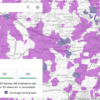As intensive care units hit capacity in many parts of the world, doctors are having to make hard decisions about who gets a bed amid a global pandemic.
While most people who contract COVID-19 ultimately recover, some can go on to develop severe pneumonia at a rapid pace that causes diffuse damage, acute lung failure, and even death.
Now, a new machine learning algorithm could help us figure out who is most at risk, so we can intervene early and hopefully save their lives.
Recent machine learning approaches have tended to rely solely on chest scans to predict who might need a hospital bed. The algorithms search the scans for lung abnormalities and can detect COVID-19-related pneumonia in roughly 90 percent of cases.
But what these scans can’t tell us with nearly as much accuracy is how severe those cases might become, and who is the most vulnerable.
The new algorithm takes things a step further, by combining chest scans with non-imaging data, such as demographic information, vital signs and blood work. And it’s the best we have so far at predicting when someone needs ICU intervention.
To be fair, the approach has only been tested using health data from 295 patients, hospitalised for COVID-19 either in the United States, Iran or Italy. But even in these early stages, it was able to predict as many as 96 percent of all COVID-19 cases that would require ICU admission, according to a preprint paper.
“As a practitioner of AI, I do believe in its power,” says engineer Pingkun Yan from Rensselaer Polytechnic Institute.
“It really enables us to analyze a large quantity of data and also extract the features that may not be that obvious to the human eye.”
During a global pandemic, that sort of insight is invaluable and potentially life-saving. Those who develop the most severe cases of COVID-19 pneumonia should have a number of common features; finding the right ones is a lot quicker for a clever machine than it is for a human.
Already, machine learning tools have been used to assess which signs are most likely to predict COVID-19 mortality.
Initial findings suggest ventilator use and potassium levels are the most important non-imaging variables, although other contributors have also been identified, including lymphocyte percentage, total bilirubin, creatinine, and albumin levels to name a few.
One study even found non-imaging data alone, including age, fever, and abnormal breathing could predict whether patients with COVID-19 need to be admitted to the ICU.
The new algorithm goes a step further. First, it quantifies the extent and volume of lung features. Then, it focuses on those features that are most important in predicting COVID-19 pneumonia. Lastly, it uses other contextual factors to predict which cases will turn out the most severe.
“To the best of our knowledge, this is the first study that uses holistic information of a patient including both imaging and non-imaging data for outcome prediction,” the authors claim.
The team hopes with further refinement, the tool can one day be used to screen for high-risk patients with COVID-19 pneumonia, who require closer monitoring and care.
While the team didn’t test how COVID-19 pneumonia compares to other respiratory diseases, the broad similarities in lung distress suggest the algorithm might prove useful even when the pandemic is over.
“We actually are seeing that the impact could go well beyond COVID diseases. For example, patients with other lung diseases,” Yan says.
“Assessing their heart disease condition, together with their lung condition, could better predict their mortality risk so that we can help them to manage their condition.”
The preprint study was published in Medical Image Analysis.



